Heated floors offer benefits beyond foot comfort. They keep entry and bathroom floors dry, are completely silent, can reduce heating bills and are an allergen free type of heating—a relief for Asthma and allergy sufferers.
Beyond the radiant heat provided by floor heating, a floor heating system also works on the principle of convection, meaning natural air circulation will force warm air up from the floor to the rest of the room. Having your floor heated can also eliminate it as one of the major sources for heat loss in a building and can reduce the reliance on other convection style heating.
One of the most common systems of floor heating seen in Australia is the hydronic (hot water) system, which provides radiant heat to a room by passing heated water through pipes circulating within the floor slab, topping screed or below the floor. The water is warmed by a heat source to around 40-55ºC and pumped at low pressure throughout the pipes to keep the floor at a comfortable temperature of between 22- 30ºC. A thermostat tells the heat source and pump when to work and a manifold directs water to different piping circuits situated throughout a building.
The major components of a Hydronic system are the heat source, manifold, floor piping and a thermostat, and there have been significant upgrades to all of these technologies of late.
THE HEAT SOURCE:
A major benefit of hydronic heating, and one of the major reasons that it is seeing an increasing specification in Australian buildings, is that the heat sources used to warm the water can be powered by energy efficient and environmental means such as natural gas and LPG, heat and geo-exchange pumps, solar evacuated tubes and even wood stoves.
The type and amount of heat energy required by a heat source is determined by the size, location and insulation performance of the space to be heated, and should be a project -specific calculation.
Geo exchange:
A geoexchange system comprises an earth pipe loop and a ground source heat pump. The loops are constructed of Polyethylene (PE) pipe in a vertical (borehole) or horizontal (trench) configuration and use water as the heat transfer fluid. Water is pumped through the ground -loop, extracting heat from the earth or a body of water, before it is distributed throughout the flooring pipes to heat the floor.
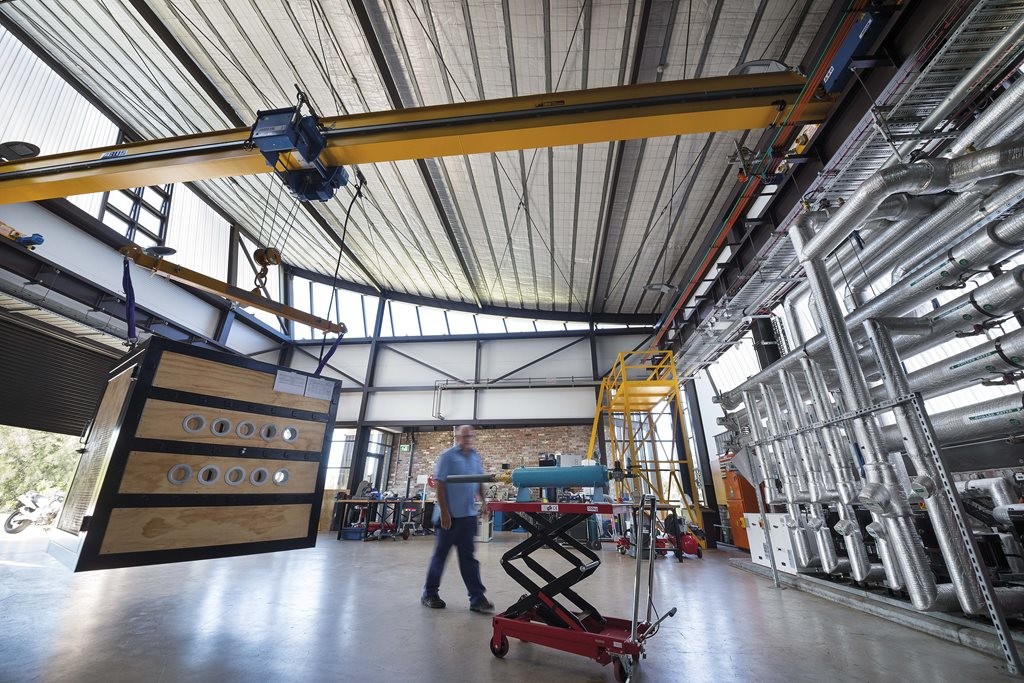 Cox Architecture’s Sustainable Buildings Research Centre (SBRC) at NSW’s University of Wollongong uses a geo source heat exchanger that feeds ground tempered water into the building’s in-slab hydronic system. Keeping with the building’s nature as a test bed for sustainable technology in Australia, Cox chose both a vertical borehole and horizontal pit loop to test the efficiencies of both systems. The system is an Envision® Series NSKW from Geo Exchange Australia. Image: John Gollings.
Cox Architecture’s Sustainable Buildings Research Centre (SBRC) at NSW’s University of Wollongong uses a geo source heat exchanger that feeds ground tempered water into the building’s in-slab hydronic system. Keeping with the building’s nature as a test bed for sustainable technology in Australia, Cox chose both a vertical borehole and horizontal pit loop to test the efficiencies of both systems. The system is an Envision® Series NSKW from Geo Exchange Australia. Image: John Gollings.
Gas:
Gas is the most popular, easiest and most cost effective installation option for hydronic floor heating and can be installed when space is limited. Most gas packaged boilers come with an inbuilt pump, expansion tank, safety valves and temperature controls.
Natural gas is much more cost effective to run than LPG and new condensing technology is seeing gas hydronic heating systems become even more efficient and better for the environment.
Condensing boilers work by recovering as much of the waste heat that is normally rejected to the atmosphere from the flue of a conventional (non-condensing) boiler as possible. This is accomplished by using an extra-large heat exchanger or sometimes two heat exchangers within the boiler. By doing this, the flue gases emit 90 per cent less CO and 80 per cent less NOx (acid rain) compared to conventional boilers.
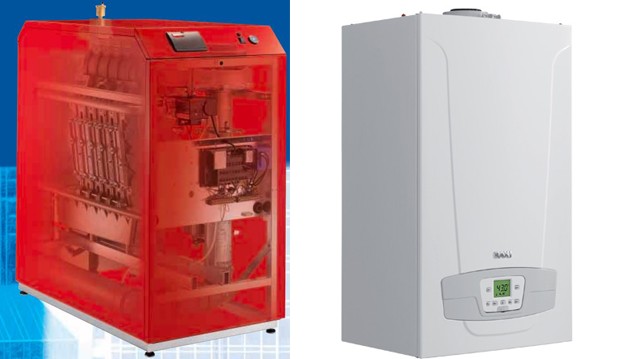 LEFT: The Saint Roch Superior Gas boiler, available from Hurll Nu-Way Australia is a compact condensation boiler that claims to have efficiency of up to 108 per cent.
LEFT: The Saint Roch Superior Gas boiler, available from Hurll Nu-Way Australia is a compact condensation boiler that claims to have efficiency of up to 108 per cent.
RIGHT: The Baxi Luna Duo-Tec GA Condensing Boiler from Hydro Heat is marketed for domestic use. It has an inbuilt modulating pump and can achieve 96 per cent efficiency.
Wood fire:
As the name suggests, the heat exchange process in a wood fired system comes from the burning of wood in a stove which is fitted with an inbuilt water jacket or ‘wet back’. The water in the jacket is warmed and then pumped throughout the floor when it is at a steady 45 ºC. Because of their nature, wood fired systems take longer to get the water temperature suitable for heating. They can also experience some issues if the thermostat is not properly installed and water is returning to the boiler to cold.
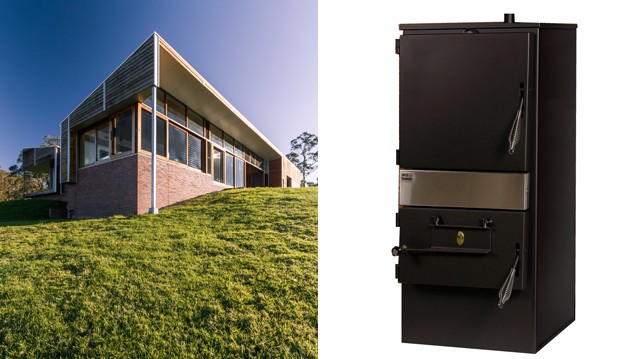 LEFT: “House for Bob and Susan” by Austin McFarland Architects uses a wood fired wetback heat source for the hydronic in-floor heating. Image: Alec Hamilton.
LEFT: “House for Bob and Susan” by Austin McFarland Architects uses a wood fired wetback heat source for the hydronic in-floor heating. Image: Alec Hamilton.
RIGHT: The Dynamic Belvedere 5000 is a dedicated boiler from Wise Living Products Australia capable of providing 50kw of heat. It is suitable for in-floor slab heating as it has a high output, spacious firebox and high capacity water jacket that enables the initial temperature rise required for in-slab heating.
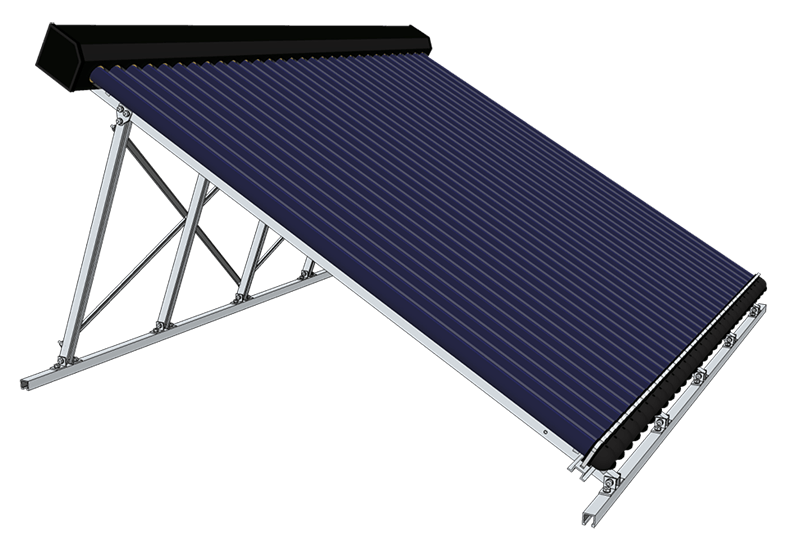 Solar evacuated tubes:
Solar evacuated tubes:
Solar evacuated tubes have come to the Australian market and are replacing flat plate collectors as they are more efficient in cloudy and cold conditions. The system consists of lines (usually between eight and 12) of double glass tubes filled with water that are oriented to absorb the sun’s solar radiation. Once the water is warm enough, it is sent down to a heat exchange tank and then out into the hydronic heating circuit. Because the output of solar is unregulated a solar evacuated tube system requires a suitably large storage tank and is generally used in conjunction with a backup boiler that is automatically turned on when the water needs a heating boost.
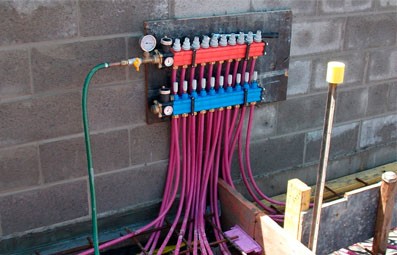
MANIFOLD AND PIPING:
A manifold is used to distribute and balance the water flow to each piping circuit situated across the building’s floors and should be situated above the height of the flooring pipes. Manifolds can include circuit isolation valves, temperature indicators, actuators and balancing adjustments, and new technology is seeing these functions incorporated into building management systems.
Piping technology has plateaued and most suppliers offer a slightly different version of a cross linked polyethylene pipe that have oxygen diffusion barriers to reduce the risk of corrosion damage to ferrous components in the heating system.
Generally speaking, manifold and piping installation is done at the same time by a single company.
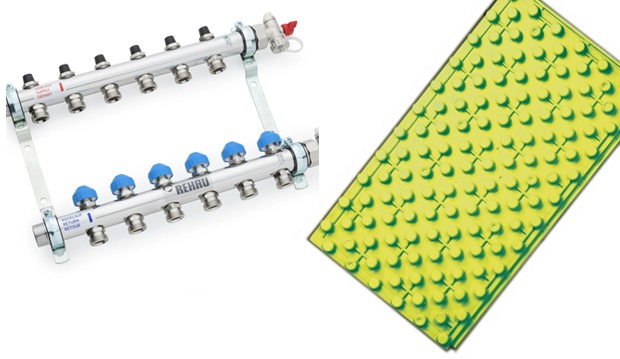 TOP: Comfort Heat uses a modular manifold which includes circuit isolation valves, balancing adjustments, automatic air-bleed and temperature indicators. With the addition of an electric solenoid motor it is possible to turn a pipe circuit on or off either for temperature control or zone isolation.
TOP: Comfort Heat uses a modular manifold which includes circuit isolation valves, balancing adjustments, automatic air-bleed and temperature indicators. With the addition of an electric solenoid motor it is possible to turn a pipe circuit on or off either for temperature control or zone isolation.
LEFT: The Rehau stainless steel manifold offers the possibility of two to12 circuits -20 to 90°C temperature resistant. It is suited for sophisticated thermostat control of multiple pipe circuits and circuit isolations.
RIGHT: The Tiemme Insulation board is a two-in-one bonus for screed application. Made from foam polystyrene it acts as an insulating board (so no heat is lost into the slab) and is designed for pipe fixing with a 50mm step. Available from Australian Hydronic Supplies.
THERMOSTATS:
High quality thermostats ensure the highest efficiency of your floor heating system as they will allow you to heat specific rooms or areas independently, or program them to automatically meet weekday and weekend lifestyle needs. Most thermostats allow for both manual and programmable functioning and some can be linked to home automation systems. A good quality thermostat will allow for greater control over temperature, zoning and timing, making it easy for users to make the most out of their floor heating system.
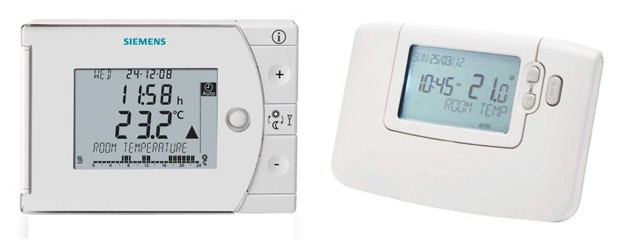
LEFT: The Siemens REV thermostats are also seven day-programmable and are available from Hurlcon Hydronic Heating.
RIGHT: The Honeywell CM907 is suitable for the general purpose control of boilers, zone valves, circulation pumps, thermal actuators, electric heaters, and heat pumps in heating or cooling systems. It has a seven day, six-periods-a-day programming function. It is available from Hydro Heat.

